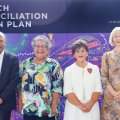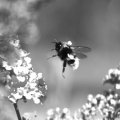World Wide Web sites designed and maintained by two University of Queensland mathematicians have been listed among the top 500 science sites in the world in a leading guide to Web resources.
Dr Phil Pollett's The Probability Web and Dr Keith Matthews' The Number Theory Web are listed among the top 500 science sites in the 1996 Springer-Verlag publication Science on the Web: A Connoisseur's Guide to Over 500 of the Best, Most Useful and Most Fun Web Sites by Edward Renehan.
In his introduction, Mr Renehan describes the book as a 'guide to the most useful and informationally rich resources for scientists on the Web.'
'I have scoured the various Web information options in a range of scientific disciplines and cut out the shallow and trivial in favour of the deep and meaningful. Thus what you have here is a directory of the most ambitious science pages on the Web, not only rich in links that leverage to the utmost the possibilities of hypertext but also rich in layers of vital, current data as represented in text, graphics and audio.'
Dr Pollett's site also recently received an Editor's Choice Award from LookSmart, an online Web directory maintained and edited by Readers' Digest.
Last year, following requests from two eminent mathematicians, Dr Matthews created 'mirror' Number Theory Web sites at the University of Rome and the University of Georgia. As the name suggests, mirror sites reflect the original site and are automatically updated each day by information from the mother site. 'The sites' purpose is to make access quicker for people living in America or Europe,' Dr Matthews said.
Self-taught in computer languages and techniques such as Java, Forms and image maps, both Mathematics Departments academics began their Web sites in late 1995 as a way of bringing together academics and issues in their respective fields of study.
'The simple, text-based and information-based sites aim to assist researchers and scholars by acting as an umbrella of the Internet resources available in the two fields,' Dr Matthews said.
'Both web sites have given the University's Mathematics Department a significant presence on the Web, enhancing the Department's reputation both nationally and internationally as one of the best and most innovative mathematics groups in the world,' Dr Pollett said.
'We have made contact with hundreds of mathematicians we would otherwise never have met and have been able to inform them about mathematical research conducted at the University of Queensland. We can access their papers and vice versa, helping advance research in probability and number theory,' Dr Matthews said.
Featuring links to research groups, abstracts of recent research papers, job advertisements, conference information and book reviews, Dr Pollett's site (http://www.maths.uq.edu.au/~pkp/probweb/probweb.html) is accessed around 500 times a week.
'It is especially convenient for academics and others wishing to access latest research papers. Instead of ringing or writing the academic concerned then waiting for a paper to be delivered by post, they can download papers from a central site in a matter of minutes,' Dr Pollett said.
Probability Theory involves modelling random phenomenon and can be applied to many everyday situations. 'For example, probability theory can be used to model calls passing through telecommunications networks to ensure these do not become overloaded,' Dr Pollett said.
He said his site also featured links to a young mathematicians' network allowing younger academics to discuss problems and search for jobs.
Dr Matthews' site (http://www.maths.uq.edu.au/~krm/web.html) collects and disseminates information of interest to number theorists, facilitating communication between them. It provides links to nearly 500 number theorists' home pages throughout the world, centres, book descriptions, surveys, recent theses, conference information and libraries with good collections in the number theory field.
'Number theory is one of the oldest branches of pure mathematics and has been traditionally studied for its own intrinsic beauty. However, in the last 20 or so years, it has found applications in data encryption in banking and computer security,' Dr Matthews said.
For more information, contact Dr Matthews (telephone 3365 3267) or Dr Pollett (telephone 3365 3459).



